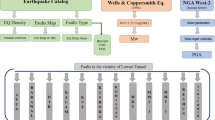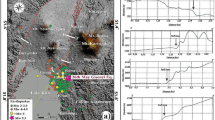Abstract
Strong ground motion records are most significant as it provides the contextual for seismic resilient design analysis. Peak acceleration attenuation relations for horizontal and vertical components from 2005 to 2017 are presented for Bangladesh and North-East Indian region based on 1608 three-component component (North–South, East–West and Vertical) accelerograms related to 160 earthquakes. The dataset consists of earthquakes with moment magnitudes from 2 to 8 with hypocentral distances up to 1000 km as recorded on 163 stations. All these strong ground motion recording stations are operated by Indian Meteorological Department in North-East Indian region and Bangladesh. The goal of this research is to acquire strong ground-motion data and develop predictive attenuation equations by multistage regression for the study region using models proposed by Joyner and Boore (Bull Seismol Soc Am 71(6):2011–2038, 1981) and Bommer and Akkar (Earthq Spectra 28(1):1–15, 2012). In this research, ground-motion prediction attenuation equations are constructed for both horizontal and vertical ground motions (e.g. peak ground acceleration, peak ground velocity) and spectral values (0.3 s, 1.0 s, 2.0 s.) for rock and firm soil. The predictive values of horizontal and vertical component for firm soil site are larger than those of rock site under the same conditions for a given earthquake event. This study also proves that, predictive attenuation model residuals are distance and magnitude independent for rock and firm soil site categories. This research reveals that rock site data fits relatively well with Bommer and Akkar (2012) model whereas firm soil site data fits well with Joyner and Boore (1981) model.


















Similar content being viewed by others
References
Abrahamson N, Silva WJ (1997) Empirical response spectral attenuation relations for shallow crustal earthquakes. Seismol Res Lett 68(1):94–127
Ambraseys N (1985) Intensity-attenuation and magnitude-intensity relationships for northwest European earthquakes. Earthq Eng Struct Dyn 13(6):733–778
Anderson JG, Lei Y (1994) Nonparametric description of peak acceleration as a function of magnitude, distance, and site in Guerrero, Mexico. Bull Seismol Soc Am 84(4):1003–1017
Ansary MA, Yamazaki F (1998) Behavior of horizontal and vertical SV at JMA sites, Japan. J Geotech Geoenviron Eng 124(7):606–616
Atkinson GM, Adams J (2013) Ground motion prediction equations for application to the 2015 Canadian national seismic hazard maps. Can J Civ Eng 40(10):988–998
Bindi D, Luzi L, Pacor F, Franceschina G, Castro R (2006) Ground-motion predictions from empirical attenuation relationships versus recorded data: The case of the 1997–1998 Umbria-Marche, central Italy, strong-motion data set. Bull Seismol Soc Am 96(3):984–1002
Bindi D, Massa M, Luzi L, Ameri G, Pacor F, Puglia R, Augliera P (2014) Pan-European ground-motion prediction equations for the average horizontal component of PGA, PGV, and 5%-damped PSA at spectral periods up to 3.0 s using the RESORCE dataset. Bull Earthq Eng 12(1):391–430
Bolt BA (2004) Seismic input motions for nonlinear structural analysis. ISET J Earthq Technol 41(2):223–232
Bommer JJ, Akkar S (2012) Consistent source-to-site distance metrics in ground-motion prediction equations and seismic source models for PSHA. Earthq Spectra 28(1):1–15
Boore DM, Atkinson GM (2008) Ground-motion prediction equations for the average horizontal component of PGA, PGV, and 5%-damped PSA at spectral periods between 0.01 s and 10.0 s. Earthq Spectra 24(1):99–138
Boore DM, Joyner WB (1982) The empirical prediction of ground motion. Bull Seismol Soc Am 72(6B):S43–S60
Boore DM, Joyner WB, Fumal TE (1997) Equations for estimating horizontal response spectra and peak acceleration from western North American earthquakes: a summary of recent work. Seismol Res Lett 68(1):128–153
Borcherdt RD (1994) Estimates of site-dependent response spectra for design (methodology and justification). Earthq Spectra 10(4):617–653
Bozorgnia Y, Niazi M (1993) Distance scaling of vertical and horizontal response spectra of the Loma Prieta earthquake. Earthq Eng Struct Dyn 22(8):695–707
Bradley BA (2010) NZ-specific pseudo-spectral acceleration ground motion prediction equations based on foreign models. University of Canterbury, 319 pp.
Campbell KW (1981) Near-source attenuation of peak horizontal acceleration. Bull Seismol Soc Am 71(6):2039–2070
Campbell KW (1985) Strong motion attenuation relations: a ten-year perspective. Earthq Spectra 1(4):759–804
Campbell K (1994) Summary of hybrid empirical approach for estimating ground motions in the central and eastern United States. Paper presented at the Proceedings, Second SSHAC Ground-Motion Workshop
Chen L, Faccioli E (2008) Ground motion attenuation relationships based on Chinese and Japanese strong ground motion data. European School for Advanced Studies-Reduction of Seismic Risk, Rose University
Cornell CA, Banon H, Shakal AF (1979) Seismic motion and response prediction alternatives. Earthq Eng Struct Dyn 7(4):295–315
Crouse C, McGuire J (1996) Site response studies for purpose of revising NEHRP seismic provisions. Earthq Spectra 12(3):407–439
Cui J, Li S, Gao D, Zhao Y, Bao Y (2006) Ground motion attenuation relations in the Yunnan area. J Seism Res 29(14):386–391
Doǧangün A (2004) Performance of reinforced concrete buildings during the May 1, 2003 Bingöl Earthquake in Turkey. Eng Struct 26(6):841–856
Fukushima Y, Tanaka T (1990) A new attenuation relation for peak horizontal acceleration of strong earthquake ground motion in Japan. Bull Seismol Soc Am 80(4):757–783
Graizer V, Kalkan E (2007) Ground motion attenuation model for peak horizontal acceleration from shallow crustal earthquakes. Earthq Spectra 23(3):585–613
Hasegawa H, Basham P, Berry M (1981) Attenuation relations for strong seismic ground motion in Canada. Bull Seismol Soc Am 71(6):1943–1962
Herak M, Markušić S, Ivančić I (2001) Attenuation of peak horizontal and vertical acceleration in the Dinarides area. Stud Geophys Geod 45(4):383–394
Hu Y, Zhang M (1984) A method of predicting ground motion parameters for regions with poor ground motion data. Earthq Eng Eng Vib 4(1):1–11
Hwang H, Huo J-R (1997) Attenuation relations of ground motion for rock and soil sites in eastern United States. Soil Dyn Earthq Eng 16(6):363–372
Idriss IM (1991) Earthquake ground motions at soft soil sites. Int Conf Rec Adv Geotech Earthq Eng Soil Dynamics 3:2265–2272
Idriss I (2008) An NGA empirical model for estimating the horizontal spectral values generated by shallow crustal earthquakes. Earthq Spectra 24(1):217–242
Joyner WB, Boore DM (1981) Peak horizontal acceleration and velocity from strong-motion records including records from the 1979 Imperial Valley, California, earthquake. Bull Seismol Soc Am 71(6):2011–2038
Joyner WB, Boore DM (1982) Prediction of earthquake response spectra: US Geological Survey Open-file report
Liao Y, Meneses J (2013) Engineering characteristics of ground motion records from the 2010 Mw 7.2 El Mayor-Cucapah earthquake in Mexico. Earthq spectra 29(1):177–205
Malone SD, Bor S-S (1979) Attenuation patterns in the Pacific Northwest based on intensity data and the location of the 1872 North Cascades earthquake. Bull Seismol Soc Am 69(2):531–546
Minzheng HYZ (1984) A method of predicting, ground motion parameters for regions with poor ground motion data. Earthq Eng Eng Vib 4(1):1–11
Mohraz B (1976) A study of earthquake response spectra for different geological conditions. Bull Seismol Soc Am 66(3):915–935
Murphy JU, O’brien L (1977) The correlation of peak ground acceleration amplitude with seismic intensity and other physical parameters. Bull Seismol Soc Am 67(3):877–915
Nakamura Y (1989) A method for dynamic characteristics estimation of subsurface using microtremor on the ground surface. Railw Tech Res Inst Q Rep 30(1):25–33
Qiwen T, Zhenpeng L, Pingshan S (1986) Estimation of ground motion attenuation in china based on intensity data. Earthq Eng Eng Vib 6(1):21–36
Sabetta F, Pugliese A (1996) Estimation of response spectra and simulation of nonstationary earthquake ground motions. Bull Seismol Soc Am 86(2):337–352
Seed HB, Ugas C, Lysmer J (1976) Site-dependent spectra for earthquake-resistant design. Bull Seismol Soc Am 66(1):221–243
Sieh K, Natawidjaja DH, Meltzner AJ, Shen C-C, Cheng H, Li K-S, Suwargadi BW, Galetzka J, Philibosian B, Edwards RL (2008) Earthquake supercycles inferred from sea-level changes recorded in the corals of west Sumatra. Science 322(5908):1674–1678
Singh, J. P. (1998). Site specific ground motions for high-tech seismic design. 8th US-Japan Workshop on the Improvement of Structural Design and Construction Practices.
Somerville PG, Smith NF, Graves RW, Abrahamson NA (1997) Modification of empirical strong ground motion attenuation relations to include the amplitude and duration effects of rupture directivity. Seismol Res Lett 68(1):199–222
Trifunac M (1976) Preliminary analysis of the peaks of strong earthquake ground motion—dependence of peaks on earthquake magnitude, epicentral distance, and recording site conditions. Bull Seismol Soc Am 66(1):189–219
Wilson J, Lam N (2003) A recommended earthquake response spectrum model for Australia. Aust J Struct Eng 5(1):17–27
Author information
Authors and Affiliations
Corresponding author
Additional information
Publisher's Note
Springer Nature remains neutral with regard to jurisdictional claims in published maps and institutional affiliations.
Rights and permissions
About this article
Cite this article
Tabassum, T., Ansary, M.A. Strong Ground Motion in Bangladesh and North-East Indian Region from 2005 to 2017 and Its Prediction of Attenuation Data during Future Earthquakes. Geotech Geol Eng 38, 6011–6029 (2020). https://doi.org/10.1007/s10706-020-01410-6
Received:
Accepted:
Published:
Issue Date:
DOI: https://doi.org/10.1007/s10706-020-01410-6




